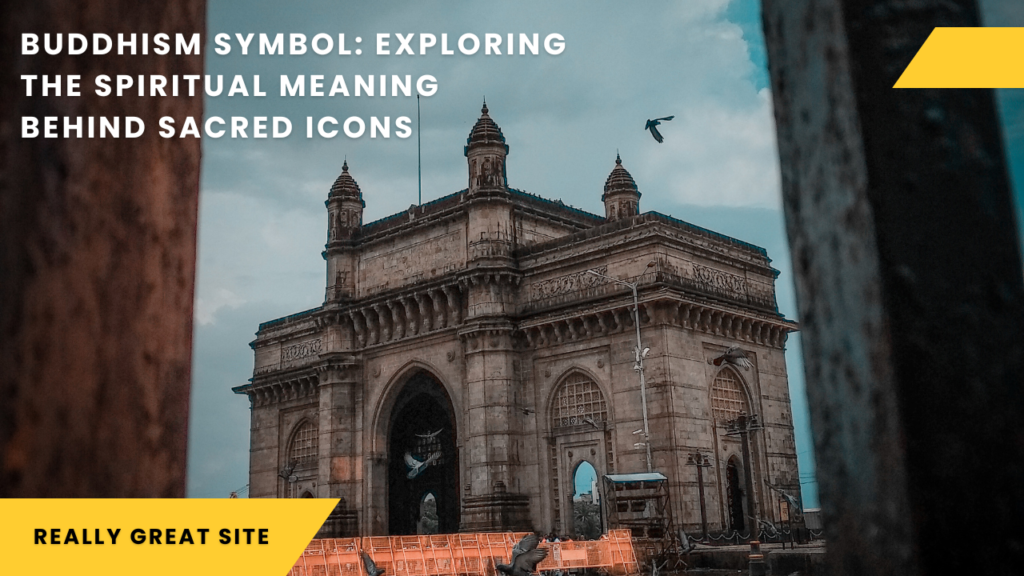Sacred symbols with deep spiritual implications abound throughout Buddhism, a spiritual religion that began in India more than 2,500 years ago. These symbols convey important facets of Buddhist theory and practice through art, meditation, rituals, and teachings. Some Buddhism Symbol: Exploring the Spiritual Meaning Behind Sacred Icons of the most well-known Buddhist symbols and their spiritual meanings are listed below:
Table of Contents
The Dharmachakra, or Dharma Wheel Buddhism Symbol
The Buddha’s teachings and the road to enlightenment are symbolized by the Dharma Wheel. The Noble Eightfold Path, which encompasses correct view, right purpose, right speech, and other elements, is represented by its eight spokes. The center of the wheel represents discipline and spiritual focus.

The Lotus Blossom
Despite growing in murky water, lotus flowers are a lovely emblem of spiritual awakening, enlightenment, and purity. Lotus flowers come in a variety of colors, each of which has a special meaning. For example, white is synonymous with purity, pink with the Buddha, and blue with knowledge.
The Infinite Thread (Shrivatsa)
All beings and events are interrelated, as symbolized by the infinite knot. It represents Buddhism Symbol the ageless essence of life and the oneness of compassion and wisdom.
The Tree of Bodhi
Siddhartha Gautama became the Buddha after achieving enlightenment under the Bodhi tree. It represents spiritual enlightenment, wisdom, and awakening.
The footprints of the Buddha (Buddhapada)
These imprints serve as a reminder of the Buddha’s teachings and actual earthly presence. They frequently feature lotuses and the Dharma Wheel as symbols, highlighting his enlightened Buddhism Symbol route.
Chatra’s Parasol Buddhism Symbol
The parasol is a representation of regal dignity and protection. It stands for the Buddha’s kind teachings, which protect disciples from pain and injury.
The Shankha Conch Shell
The conch shell represents the awakening call to mindfulness and the dissemination of Buddhist teachings. Its sound is believed to invite tranquility and drive out negativity.
Matsya, the Two Golden Fishes Buddhism Symbol: Exploring the Spiritual Meaning Behind Sacred Icons
These fish stand for pleasure and freedom, the capacity to face life’s obstacles without fear or pain.

Dorje, or the Vajra
The vajra is a ceremonial item that symbolizes a strong spiritual force and indestructibility. Buddhism Symbol: Exploring the Spiritual Meaning Behind Sacred Icons It represents the ability of wisdom to triumph against ignorance.
The stupa
A stupa is a revered structure that houses artifacts frequently connected to the Buddha or other enlightened persons. It acts as a focal point for meditation and represents the enlightened mind.
Spiritual Significance
These holy images assist practitioners in concentrating on the lessons and values of Buddhism, acting as a reminder of the way to enlightenment, knowledge, and inner serenity. They are living examples of fundamental ideas like mindfulness, compassion, connectivity, and the transience of existence.

In conclusion
Buddhist symbols have deep spiritual implications that cut beyond both culture and time. They work as potent reminders of the Buddha’s teachings, pointing followers in the direction of enlightenment, wisdom, compassion, and awareness. Each icon captures the spirit of the Buddhist path, whether it is through the beauty of the lotus flower, the parasol’s protective presence, Buddhism Symbol: Exploring the Spiritual Meaning Behind Sacred Icons or the Dharma Wheel’s symbolism of limitless wisdom.
In addition to enhancing religious ceremonies and meditation techniques, these holy symbols encourage people all throughout the world to develop inner harmony and serenity. People can develop spiritually, connect with the universal principles that Buddhism stands for, and obtain a greater understanding of the essence of existence by comprehending and using these timeless symbols into their daily lives.
Frequently Asked Questions (FAQ) About Buddhist Symbols
Q. What is the most important symbol in Buddhism?
A. The Dharma Wheel (Dharmachakra) is often considered the most significant symbol in Buddhism. It represents the Buddha’s teachings and the path to enlightenment through the Noble Buddhism Symbol: Exploring the Spiritual Meaning Behind Sacred Icons Eightfold Path.
Q. What does the lotus flower symbolize in Buddhism?
A. The lotus flower symbolizes purity, spiritual awakening, and enlightenment. Despite growing in muddy water, it blooms beautifully, representing the Buddhism Symbol: Exploring the Spiritual Meaning Behind Sacred Icons ability to rise above adversity and attain wisdom.
Q. What does the Endless Knot signify?
A. The Endless Knot (Shrivatsa) represents the interconnectedness of all existence and the harmony between wisdom and compassion. It symbolizes the timeless cycle of life and spiritual continuity.
Q. What is the significance of the Bodhi Tree?
A. The Bodhi Tree symbolizes wisdom and enlightenment. It is the sacred tree under Buddhism Symbol: Exploring the Spiritual Meaning Behind Sacred Iconswhich Siddhartha Gautama attained enlightenment, becoming the Buddha.
Q. Are Buddhist symbols used only by Buddhists?
A. No, Buddhist symbols are often appreciated and used by people of different religious backgrounds and philosophies for their spiritual meanings, aesthetic value, or as reminders Buddhism Symbol: Exploring the Spiritual Meaning Behind Sacred Icons of universal values such as peace, mindfulness, and compassion.